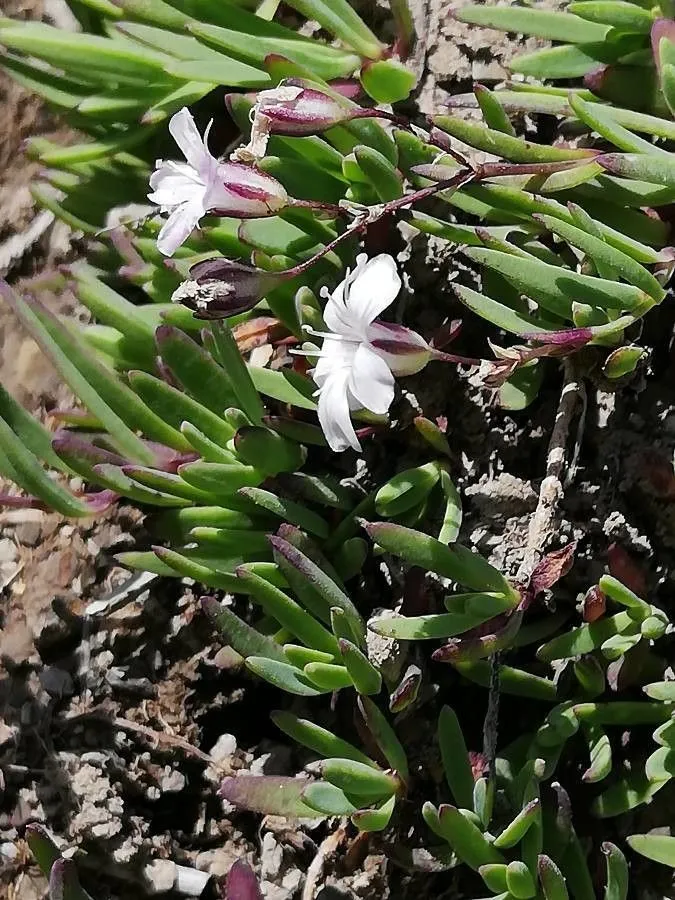
Author: L.
Bibliography: Sp. Pl.: 407 (1753)
Year: 1753
Status: accepted
Rank: species
Genus: Gypsophila
Vegetable: False
Observations: Mts. of C. & S. Europe
Alpine gypsophila, scientifically known as Gypsophila repens, is a charming perennial herb characteristic of the mountainous regions of Central and Southern Europe. This delicate yet resilient plant belongs to the Caryophyllaceae family, known for its prolific and attractive bloom. The first formal description of this species was recorded in 1753 by the renowned botanist Carl Linnaeus, a testament to its longstanding presence and significance in botanical literature.
Gypsophila repens thrives in the challenging environments of alpine meadows and rocky slopes, where it exhibits a creeping growth habit. This low-growing perennial forms dense mats of foliage that can extend over a considerable area, making it a formidable ground cover in its native habitats. The slender stems and narrow, gray-green leaves contribute to its delicate appearance, blending seamlessly into the rugged terrain.
One of the most captivating features of Alpine gypsophila is its prolific bloom of small, star-shaped flowers, which typically occur from late spring to early summer. The blossoms, often white or pale pink, create a carpet of color that contrasts beautifully with the stark landscapes of its native high-altitude environments. These flowers not only enhance the visual appeal of the plant but also attract a variety of pollinators, including bees and butterflies, playing a crucial role in the alpine ecosystem.
Gypsophila repens is well-adapted to the harsh conditions of its native range, demonstrating significant tolerance to cold temperatures and poor soil conditions. This resilience makes it a popular choice for gardeners looking to add a touch of alpine charm to rock gardens, borders, and other landscapes that mimic its natural habitat. Due to its creeping nature, it also serves as an effective ground cover, helping to suppress weeds and retain soil moisture.
In addition to its aesthetic appeal, Alpine gypsophila holds value in traditional herbal medicine, where it has been used for its mild astringent and diuretic properties. Though not as prominent as other medicinal plants, it contributes to the diverse pharmacopoeia of alpine flora.
In summary, Gypsophila repens or Alpine gypsophila is a hardy and elegant perennial that embodies the beauty and resilience of alpine ecosystems. Its delicate flowers and creeping growth habit make it a cherished addition to both natural landscapes and cultivated gardens, celebrating the rich botanical heritage of Central and Southern Europe’s mountainous regions.
Eng: creeping baby’s-breath, alpine gypsophila
Lit: guls
Deu: kriechendes gipskraut, teppich-scheierkraut
Fra: gypsophile rampante
Swe: hängslöja
En: Alpine gypsophila, Creeping baby’s-breath, Trailing Baby’s-breath
Ca: Gipsòfila repent
Cs: Šater plazivý
Nl: Kruipend gipskruid
Et: Roomav kipslill
Fi: Mätäsharso
Fr: Gypsophile rampante
De: Teppich-Scheierkraut, Kriechendes Gipskraut
Hu: Kúszó fátyolvirág
It: Gipsofila strisciante
Lt: Guls
Pl: Łyszczec rozesłany
Ru: Качим ползучий
Sv: Hängslöja
Taken Aug 13, 2021 by Helga Kautsch (cc-by-sa)
Taken Jan 1, 1800 by Tela Botanica − Thierry Pernot (cc-by-sa)
Taken Jun 24, 2020 by naturnah (cc-by-sa)
Taken Aug 24, 2006 by Francois Mathieu (cc-by-sa)
Taken Jul 26, 2018 by mdiest (cc-by-sa)
Taken Sep 28, 2015 by Tela Botanica − Alain BIGOU (cc-by-sa)
Taken Aug 5, 2021 by Pietro Brignoli (cc-by-sa)
Taken Aug 27, 2022 by Kai Best (cc-by-sa)
Taken Aug 25, 2019 by marlies schneider (cc-by-sa)
Taken Aug 10, 2022 by Lüdtke Allen Scott (cc-by-sa)
Taken Mar 8, 2020 by kokoss kokoss (cc-by-sa)
Taken Jun 10, 2017 by Yoan MARTIN (cc-by-sa)
Taken Sep 28, 2015 by Tela Botanica − Alain BIGOU (cc-by-sa)
Taken Aug 10, 2022 by Lüdtke Allen Scott (cc-by-sa)
Taken Aug 25, 2019 by marlies schneider (cc-by-sa)
Taken Aug 28, 2022 by -San- (cc-by-sa)
Taken Aug 7, 2007 by EOL − Amadej Trnkoczy (cc-by-nc-sa)
Taken Jul 14, 2009 by EOL − Amadej Trnkoczy (cc-by-nc-sa)
Taken Jun 10, 2017 by Yoan MARTIN (cc-by-sa)
Taken Aug 3, 2022 by Tristan Jaton-Maria (cc-by-sa)
Taken Jan 1, 1900 by EOL − Ghislain118 (AD) http://www.fleurs-des-montagnes.net (cc-by-sa)
Taken Jul 8, 2020 by Dieter Albrecht (cc-by-sa)
Taken Jan 1, 1900 by EOL − Encyclopedia of Life (cc-by-sa)
Taken Jan 1, 1900 by EOL − H. Zell (cc-by-sa)
Taken Jun 10, 2017 by Yoan MARTIN (cc-by-sa)
Taken Jul 15, 2008 by Photoflora – Benoit BOCK (©)
Taken Jul 15, 2005 by Photoflora – Bernard TILLY (©)
Taken Jan 1, 1900 by EOL − Meneerke bloem (cc-by-sa)
Taken Jan 1, 1970 by Photoflora – L’Abbé COSTE (©)
Taken Aug 5, 2021 by Pietro Brignoli (cc-by-sa)
© copyright of the Board of Trustees of the Royal Botanic Gardens, Kew.
© copyright of the Board of Trustees of the Royal Botanic Gardens, Kew.
Growth habit: Forb/herb
Bloom months: [‘jun’, ‘jul’, ‘aug’, ‘sep’]
Family: Myrtaceae Author: (F.Muell.) K.D.Hill & L.A.S.Johnson Bibliography: Telopea 6: 402 (1995) Year: 1995 Status:…
Family: Rubiaceae Author: Pierre ex A.Froehner Bibliography: Notizbl. Bot. Gart. Berlin-Dahlem 1: 237 (1897) Year:…
Family: Sapindaceae Author: Koidz. Bibliography: J. Coll. Sci. Imp. Univ. Tokyo 32(1): 38 (1911) Year:…
Family: Asteraceae Author: A.Gray Bibliography: Pacif. Railr. Rep.: 107 (1857) Year: 1857 Status: accepted Rank:…
Family: Fabaceae Author: Medik. Bibliography: Vorles. Churpfälz. Phys.-Ökon. Ges. 2: 398 (1787) Year: 1787 Status:…
Family: Aspleniaceae Author: (Cav.) Alston Bibliography: Bull. Misc. Inform. Kew 1932: 309 (1932) Year: 1932…